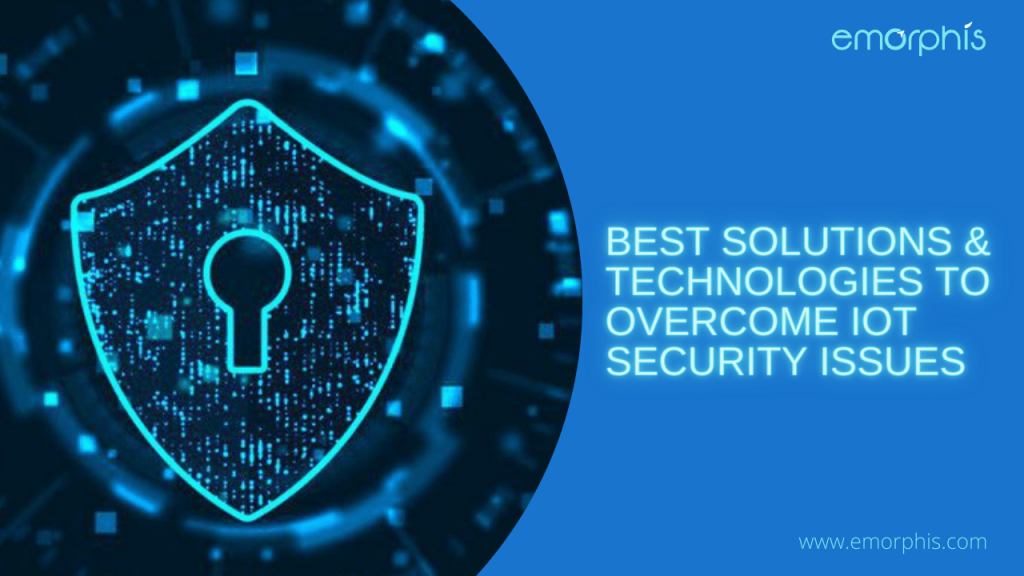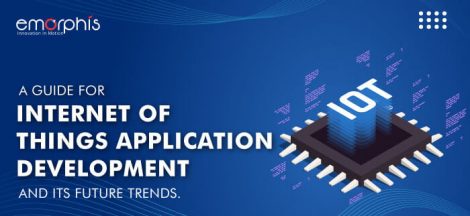The ‘Internet of Things’ or simply IoT; is evolving at a great pace to become one of the fastest-growing enterprises whole over the business world. A recent report on IoT security states that spending on IoT-related devices will soon reach $1.6 billion just in the next five years. Furthermore, the widespread popularity of IoT devices has resulted in more and more people opting for IoT app development. So, many financial opportunities have come to the front, yet some concerns concerning security have also come to the floor.
Security issues have devastated the growth of IoT technology and also created a barrier to having successful integration into all the business spheres (ranging from smart homes to large industrial estates). To cope with it successfully, many Internet of Things or IoT application development companies are in fact, searching for new tools and technology to enlarge their IoT security standard manifold.
Now, the focus will shift towards understanding the seriousness of security for IoT devices!
Why IoT Security is so Critical?
Before moving forward, it is important to get an understanding of IoT. Basically, IoT is an interconnection of devices with the internet to have mutual sharing of data. It includes not only PCs, laptops, or smartphones, but also objects equipped with chips to communicate data over a network.
The global IoT market will be worth $1.11 trillion by 2026, much higher than $190 billion in 2018! What does the given fact reveal? It discloses that there has been significant growth in the IoT market that will not die so soon.
Nevertheless, the continuous success of IoT at a global level has made it work under the constant threat of data privacy and security breach, and even unwanted monitoring. A recent report on cybersecurity says that there has been a 300% increase in cyber-attacks on IoT devices since last year.
Likewise, findings from Statista disclose that by 2021, most organizations across the globe will be spending over $3,118 million on securing their devices. So, it is no surprise that most companies are spending a large amount to protect their IoT devices from cyber-attacks that might severely affect the working of the devices. Some major reasons make the security of IoT devices more important.
I. Nothing is more important than ‘Data’
IoT devices contain a large amount of personal data that also makes them a target for hackers or other unethical users. What will happen if the data falls into the wrong hands? It will also result in compromising the working of all the companies and might affect their reputation.
II. Highly Vulnerable IoT Devices Encourage Hackers
IoT technology is still in its nascent phase. The developers still lack adequate hardware to analyze and encrypt data in the limited available space. Furthermore, no synchrony across the several platforms renders them helpless in creating uniform security protocols.
III. Cyber Attack Compromises the Aim of IoT Execution
One of the drawbacks of IoT devices is that there is no development of robust privacy protection laws. In fact, it is a loophole that is exploited well by hackers. Besides, it also results in severe loss of revenue deriving from the investment into IoT product-based ventures.
What Challenges do Developers Face in Offering Security for IoT devices?
There are various challenges faced by the IoT app solution that result in their slow development and also, adoption rate. They arise from both users and manufacturers and the reason is due to:
- Lack of adequate knowledge among the users
- Inconsistency in maintaining the production standards
- Pitiable updates and maintenance of IoT devices
- Use of insecure passwords
- The high cost of maintenance security
- High Vulnerability due to the involvement of humans
Now, let’s talk about some of the challenges faced by IoT companies that are more threatening to them.
A. No Acceptance of Industry-level Standards
There is an acute shortage of security for IoT devices as the developers also, know nothing about a secure IoT system. It happens due to the absence of a reliable security standard that makes the adoption of devices slow and incompatible.
B. IoT Driven Financial Offence
IoT apps also, find more acceptance among electronic payment companies that have resulted in a high level of financial crime and identity fraud. Due to this, the companies face operational and experience compliance issues.
C. Lack of Awareness among Users of IoT devices
IoT is a new technology, and thus it is still unknown among most of the users. Although they know about protecting their devices from any virus or phishing attacks, they still lack the knowledge to protect their IoT devices appropriately.
D. Utilization of Unreliable Passwords
Often, users secure their IoT devices with passwords as a matter of fact, that are easy to figure out. Moreover, as IoT security is costly to maintain, it becomes important for users to use passwords that might not be easy for hackers to crack.
E. Insufficient Testing with Fewer Updates
IoT devices face frequent cyber-attacks due to the carelessness of the developers in conducting proper testing with availing timely software updates. In fact, it happens as manufacturers are in a hurry to launch their products without conducting proper testing.
After getting to know about numerous challenges with IoT security, in fact, the time has come to move towards identifying some crucial tips to secure them successfully.
Tips to Secure the IoT Devices
There is a saying: “The first security rule is that there is no presence of any type of security.” So, offering the security of IoT devices has to come with more creativity.
Keeping the above-given phrase in mind, every expert points to the security service provider for knowing every incoming and outgoing data in their infrastructure (including servers, monitors, also other devices). Furthermore, they also suggest removing or updating anything that has become outdated.
Though it might sound simple, still it is hard to figure out! Nevertheless, companies are still figuring out some of the essential tips that help in tracking their IoT-based devices and in fact, flush out vulnerabilities present in them. Some of them are as follows:
A. Keeping Security in Mind, Built-Up Infrastructure
When starting with network architecture, it is prudent to give the main priority to the security of the IoT device. The developers also should focus on each project by making it well-documented and update or remove to enhance its infrastructure.
B. There must be Insurance of Physical Security
Thinking about IoT security, most people connect it with software which is not true. Hackers can use hardware to connect a system. So, it is essential to make a system tamper-proof to make it face any drastic situation.
C. Setting-Up of Automatic Updates
It is a challenging task to simultaneously manage the device and software without losing out on the updates. So, offering automatic updates will help the system to keep itself up-to-date and free from any unwanted phishing and virus attacks.
D. Creating Awareness among Users
IoT is the latest technology, so educating people about the given system will be the most beneficial aspect. Besides, they should warn them about the possible dangers associated with IoT apps and offer them facilities so to change their default credentials.
E. Frequent Testing of the System
To make the IoT devices more secure opting for continuous testing through emulating the real-world scenario will help in solving the critical situations well. Also, IoT security tomography will help in finding weak aspects of the software to prevent future possible attacks.
F. Thinking about API Safety
The API can become a weak point that can be exploited by hackers to infect the system. So, there must be assurance about the regular checking of API. Moreover, the focus must be on using authorized devices to prevent data manipulation.
G. Integration of Security Gateways
It is important to secure gateways as they act as a buffer zone between the network and the device. So, taking a cue for their safety by implementing firewalls will prevent hackers from affecting the given system severely.
H. Offering Education to the Developer’s Team
The main reason behind the occurrence of most of the security breaches is due to the action taken by the employees. So, they must be given training about the IoT system, and create a tight security rule that everyone must follow. Besides, they must be trained to handle any threats precisely.
No tips will work until there is no utilization of the best tools and technologies. So, the next section will emphasize five essential tools and technologies that will bring revolution in providing the best IoT security features.
Five Best IoT Security Technologies and Tools
A. IoT Encryption Security Technologies
For securing any software, its encryption is a must, whether using it on an IoT system or mobile app. It can be selected from several encryption methods, notable of them include:
- Data Encryption Standard (DES)
- Triple Data Encryption Standard (Triple DES)
- Advanced Encryption Standard (AES)
- And many more
B. IoT Authentication
One of the best security tools, it offers users to authenticate IoT devices using various robust authentic mechanisms such as digital certificates, biometrics, and 2-way authentication. Furthermore, they are M2M-based with no involvement of humans. To authenticate a system one could use:
- Message Authentication Code (MAC)
- OAuth2
- PKI
Furthermore, identification of the genuine user is also easy through using:
- Biometrics
- Username & Password
- Tokens
Besides, securing M2M endpoints needs these types of identifications:
- Shared secrets
- MAC address
- Radio-Frequency Identification (RFID)
C. IoT Network Security
In contrast to traditional network security, implementing network security for IoT devices is a challenging task due to the lack of clear standards and the use of different protocols. For securing one’s network, there should be the utilization of antimalware and antivirus programs (with taking into account firewalls also).
D. IoT Security Analytics
It uses telemetry data collected from IoT devices to detect any flaw or suspicious activity in an IoT ecosystem. Furthermore, it comes with solutions that use ML, AI, and big data technologies to offer more anomaly detection in the real-time system.
Many industrial-based IoT analytics products include:
- SAP
- Senrio
- Cisco
- Indegy
- And so on
E. IoT API Security
One of the secure technologies, it allows authentication and authorization of the data movement between back-end systems and IoT devices and apps using REST APIs. Using it, it will be easy for developers to detect potential attacks and threats against APIs.
Thus, it ensures a significant reduction in the potential attacks on the APIs successfully. Various 3rd party services offer the perfect option for IoT API security and include:
- CA Technologies
- MuleSoft
- Axway
- Akana
The Future of the Internet of Things Security
IoT technologies may be a complex procedure; still, they will become a great force to reckon with in the post-pandemic future. With rising mayhem caused by the coronavirus, people are getting more and more dependent on IoT. Nevertheless, there should not be any compromises with the security of the system working on the given technology.
Many security experts believe that IoT security will see some exciting developments when automation in systems and devices becomes necessary. It will include dynamic authorization, new authentication tools, and enhancement of behavior analysis to detect any new or existing threats alike.
But one thing will be sure to happen: online attacks will be bound to occur and increase with increased usage of the online medium. However, there is no need to worry as in the next 10 years; the greatest security advancement will come in the form of endpoint security monitoring and analysis of the machine use using AI for detecting online intruders precisely.
What’s more, businesses will opt for IoT application development solutions that offer endpoint firewalls for detecting and preventing intrusions in the IoT devices. Additionally, more people will begin utilizing software and hardware that adhere to standardized practices with better encryption and authentication services.
Regardless, there is a sense of optimism among business people about the increased usage of IoT security products across the globe. Many tech startups are opting for IoT security apps through embedded design to integrate them with their business models. It then results in the customization of the features of the services obtained from IoT security tools.
Final Thoughts
The given guide clearly defines that besides its complexity, IoT technologies will find usage in almost every aspect of the business. Many industries such as those belonging to the healthcare, finance, and banking sectors are looking towards IoT to offer the best security services to thwart any cyber intrusions.
Thus following the best practices will help the IoT developers to overcome challenges associated with IoT security and offer more secure services to increase the image of the organization manifold.
So, one thing is sure: “There is a bright future waiting for IoT to rule the top of the business world for the generation to come.”







